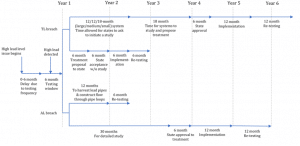EPA should protect America’s children by further revisions of the Lead and Copper Rule
By Shashank Agarwal, Kaylee McCormack, Susan Solomon | May 27, 2021
 A sign tells Flint, Mich. residents that boiling water doesn't remove lead in Februaary 2016 Months earlier, the city told citizens they could use tap water if they boiled it first. (Photo by Sarah Rice/Getty Images)
A sign tells Flint, Mich. residents that boiling water doesn't remove lead in Februaary 2016 Months earlier, the city told citizens they could use tap water if they boiled it first. (Photo by Sarah Rice/Getty Images)
Lead poisoning, sometimes dubbed a “silent pandemic,” causes a variety of tough-to-diagnose, widespread effects on humans (particularly children) including reduced IQ, memory loss, and brain, heart, and kidney damage. The lead pipes and lead solder in community water systems are a major cause of lead exposure in the United States. Despite decades of mitigation efforts, recent lead-water crises have afflicted Washington, DC in 2002, Pittsburgh, Pa. in 2012, Flint, Mich. in 2014, and Newark, N.J. in 2016. Particularly in Flint, large-scale lead-leaching was unnecessarily prolonged and caused documented increases in children’s blood lead levels. Poor, minority communities have suffered more from such crises, making lead contamination in drinking water an important environmental justice issue. The Biden administration’s infrastructure proposal includes $45 billion for nationwide replacement of lead pipes, but even if this legislation survives congressional criticisms, many Americans would remain at risk for years if not decades while such measures are complete—unless our lead regulations are immediately and effectively improved.
The EPA’s Lead and Copper Rule (LCR) of 1991 aims to protect Americans from lead contamination in water, but these recent lead crises have been attributed to its shortcomings and poor enforcement. In the aftermath of the Flint water crisis, in 2016 the EPA began a multi-year Lead and Copper Rule Revisions process, which was finalized by the Trump administration in December 2020. The Biden administration has announced plans to begin implementation of the updated form of the revised rule beginning on June 17, 2021, after a public comment period.
A study by Princeton researchers based on 20 years of data concluded that public comments have a near-zero impact on policy-making in the US, so inviting comments from the public is extremely unlikely to result in substantive changes to the revised rule. Because the revised Lead and Copper Rule remains deeply flawed and dangerous to America’s children, the EPA should instead go back to the drawing board to drastically revamp it.
To improve the near-term protection of the public, the EPA needs to make fundamental changes in the rule’s provisions for water sampling, action thresholds and timetables, and oversight.
Inadequate samplings. Ineffective sample collection and under-reporting of lead concentrations played a fundamental role in the initial masking of the Flint crisis. Although the Lead and Copper Rule revisions provides for a few improvements in sample collection and reporting methods, it is still inadequate. The revisions continue to require the collection of a very small number of samples for estimating lead levels in certain water systems. For instance, for a water provider serving a 10,000 to 100,000 population living in thousands of homes, only 60 samples are required every six months to represent lead levels in the entire system. The rule revisions leave site selection largely to local governments and water utilities, with minimal oversight of the selection of sampling sites. The laissez-faire approach to site selection along with inadequate sample density creates opportunities for selective sampling. (While in theory the rule supposedly steers sampling towards high-risk homes, in practice it has been easy for water systems to avoid areas with suspected high concentrations of lead.) So the system allows under-representation of lead levels. Further, proper water lead-sampling methodology should include multiple consecutive water samples. While initial samples from a given tap tend to better represent leaded particulates, later samples better represent dissolved-lead concentrations, and both should be measured.
But the Lead and Copper Rule Revision requires testing of only the fifth one-liter sample. The first 4 liters are just discarded, leading to a wholly inadequate picture of lead levels in a system. These shortcomings could be (and should be) resolved relatively cheaply by choosing a larger number and frequency of samples, improved sampling methodology, and more specific guidance and oversight on site selection. Remarkably, such simple provisions are still missing from the revised rule on lead and copper.
Inadequate and untimely response. In addition to the flaws in identification of lead levels, the revisions also lack a call for a timely response when high lead levels are detected. The EPA’s Lead and Copper Rule sets a limit (called the Action Level, or AL) on the maximum permissible lead concentration in water supplies before corrective action is required. The scientific community has shown that there is no “safe” lower limit of lead exposure. Lead contamination impairs cognitive development in children so severely that The American Association of Pediatrics recommends that water fountains in schools should not exceed lead concentrations of 1 part per billion. Alarmingly, the Action Level in the new rule revisions remains the same as in the original 1991 rule—15 parts per billion, which is in no way a health-based standard.
Compounding the problem, the rule revisions continue to take a lax approach to public health, failing to require any timely change by water providers until long after the public has been exposed to dangerous levels of lead for prolonged periods. Although the new rule improves upon its predecessor by adding a new Trigger Level of 10 parts per billion, requiring some measures (see figure 1) before the Action Level of 15 parts per billion is reached, but the responses at both levels remain unnecessarily drawn out. For instance, with low testing frequencies (i.e., every 6 months) and large allowed lead times before action is required (see figure 1), the new rule revisions still allow two to three years before water quality is expected to improve after exceeding the Action Level or Trigger Level. The complete process of responding to high lead levels in drinking water can take up to five years.
Similarly, the Lead and Copper Rule revisions have no provisions for immediately safeguarding the public from high lead levels by providing alternative water sources. Although new provisions have been added to require replacement of lead pipes at a rate of at least 3 percent per year in the distribution systems within two years of exceeding the Action Level, clarity on which lead pipes are to be replaced (in particular, whether this includes the service lines from water mains to individual homes) and how water systems will carry out such tasks is missing. Such loopholes may incentivize some governments and utilities to take short-term, irresponsible risks with the health of communities that have weaker political voices, as was the case in Flint. The Lead and Copper Rule revisions should be changed to dramatically reduce response times.

The passive damage-control approach. The Lead and Copper Rule Revision continues to take a passive approach to crisis control until the lead levels in drinking water reach 10 parts per billion. No proactive steps are taken if, for example, the lead concentration in municipal water increases from 5 to 10 parts per billion—a difference with notable health consequences. Increasing levels of lead should be doubly concerning; they can indicate that insufficient corrosion control is already destabilizing the protective layer of scale on lead pipe that prevents lead from leaching into the water. Without immediate corrective action, this leaching will result in long term contamination that does not resolve for months or years because scale re-forms only slowly. Although the new Trigger Level of 10 parts per billion requires water systems to re-optimize their corrosion control treatments, the long implementation times reflected in Figure 1 provide a loophole that allows significant delays in reducing lead levels. Immediate responses to increasing lead levels (such as orthophosphate treatment of the water, which helps to stabilize damaged scale) should be part of further revisions to the Lead and Copper Rule.
Not good enough. Beyond the few shortcomings of the Lead and Copper Rule Revision we have discussed are other key concerns, including the lack of accountability of officials and water systems that should monitor and control lead levels in drinking water and the need to provide incentives for active lead-control. Having waited for so long for a strong rule on lead in drinking water, America would be better off actually fixing the problem, rather than hastily instituting the result of a poor process that leaves the Lead and Copper Rule still toothless as more lead crises loom in countless cities that have lead pipes and solder in their water system. Substantive improvements of the deeply flawed Lead and Copper Rule Revision are needed to adequately and promptly protect public health.
Together, we make the world safer.
The Bulletin elevates expert voices above the noise. But as an independent nonprofit organization, our operations depend on the support of readers like you. Help us continue to deliver quality journalism that holds leaders accountable. Your support of our work at any level is important. In return, we promise our coverage will be understandable, influential, vigilant, solution-oriented, and fair-minded. Together we can make a difference.


















Rick Snyder needs to face prosecution for what he did to Flint. Then again, Roger Smith should faced prosecution for closing the GM factory and impoverishing the town.